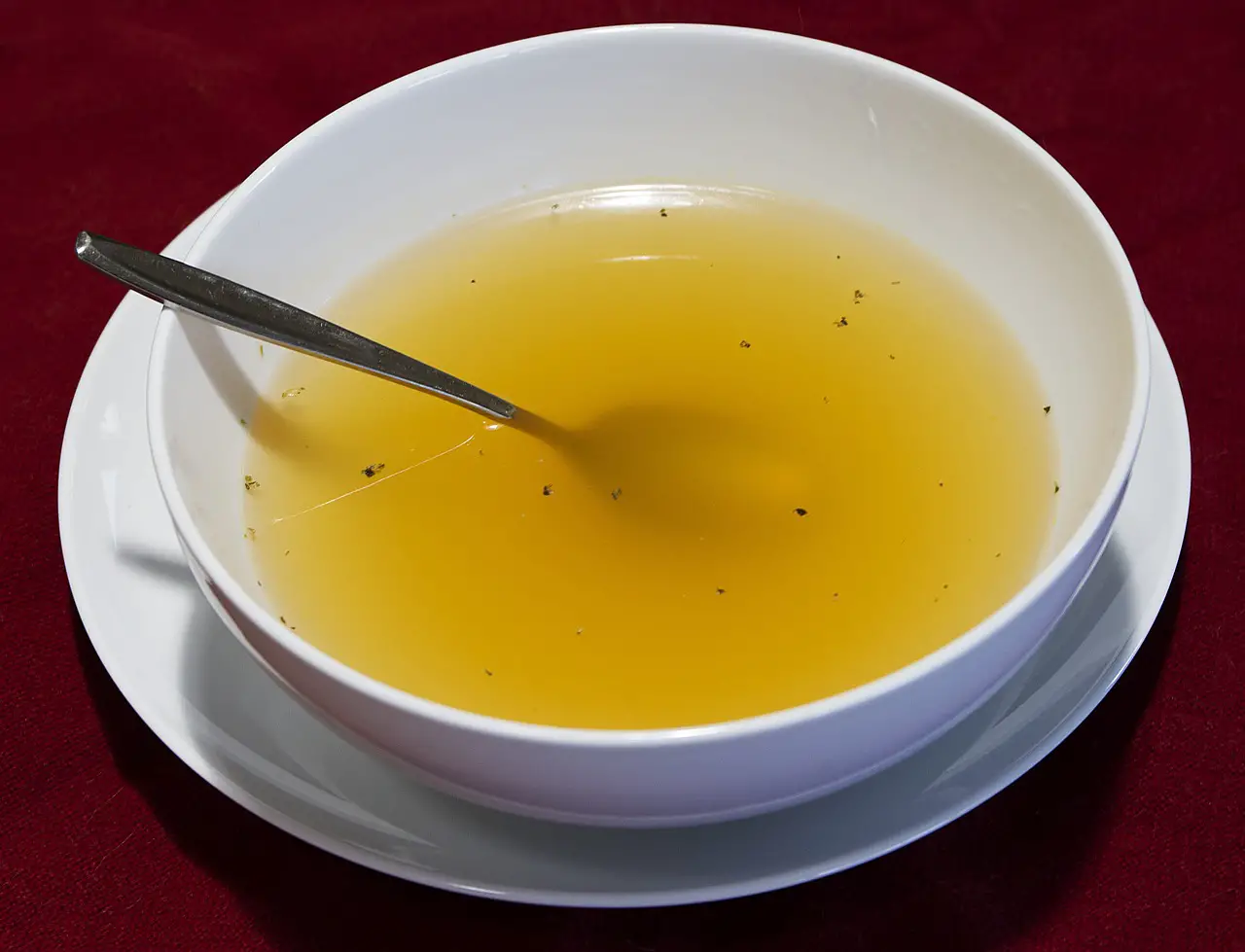If you make your chicken broth, you will want to know how long it will last in your fridge. Many people will make homemade soup and stock it, and then store it for a while before they use it. However, if you buy your broth, you might wonder if it will last longer than a week. Stored properly, your broth should have a pleasant aroma and be clear. It should also be free from sediment and coagulated chicken fat. You may need to discard your broth if it has an off-odor, a cloudy appearance, or if the seal on your container is broken.
Chicken broth has a shelf life of up to three months. The expiration date printed on the label can vary from one brand to another. However, it is recommended that you use your product before the date printed on the label. If you are unsure whether your chicken broth is still fresh, check the date stamped on the can. An off-odor is a good indicator that your broth is not fresh.

What is Chicken Stock?
Chicken bones, meat, and veggies are simmered in water to create the tasty liquid known as chicken stock. It can be consumed as a warm and pleasant beverage or as a base for soups, stews, sauces, and gravies.
Chicken bones (typically from a roasted chicken) are combined with chopped vegetables like onion, celery, carrots, herbs, and spices in a big pot to make chicken stock. The tastes and nutrients from the components are then extracted from the combination by simmering it for several hours. The resulting liquid is filtered to get rid of the solids before being put to use.
How Long is Chicken Stock Good for in the Fridge?
In the refrigerator, the homemade chicken stock will keep for approximately 3–4 days; in the freezer, it will keep for up to 6 months. Store it in an airtight container and allow it to cool to room temperature before putting it in the refrigerator to lengthen its shelf life.
Store-bought chicken stock normally has a longer shelf life and can be stored for up to 6 months in the freezer or for around 5-7 days in the refrigerator. It’s essential to check the packaging for expiration dates constantly and to store and utilize products according to the manufacturer’s recommendations.
Before utilizing chicken stock, it’s crucial to look for signs of deterioration. It is better to dump it and not use it in your cooking if the liquid has an off scent or has become hazy or discolored. In addition to ensuring the safety and quality of your food, this will also reduce the possibility of food poisoning.
How to Freeze Chicken Stock?
The easiest approach to keep chicken stock for later use is to freeze it. The following is how to freeze chicken stock:
Cool the stock: Before freezing, let the chicken stock come to room temperature. You can also swiftly cool the boiling stock by submerging it in an ice bath if you’re in a rush.
Add liquid to containers: With about 1 inch of headspace remaining to accommodate expansion during freezing, pour the chilled stock into airtight containers. You can use full freezer bags or freezer-safe plastic containers.
The date on the label Indicates the date and stock type on each container. By doing so, you can monitor your stock and prevent freezer burn.
Put the containers in the freezer to be frozen. In between two and four hours, depending on the size of the container, the stock will freeze.
Let the frozen stock defrost overnight in the refrigerator or over low heat in a saucepan when ready to use it. Thoroughly whisk the store back together before using if it separates after freezing.
It is recommended to freeze the chicken stock in tiny amounts because doing so will make it simpler to thaw only what you need and lower the chance of spoiling.
How to Thaw Frozen Chicken Stock?
The following methods can be used to defrost frozen chicken stock:
- Refrigerator approach: Thawing chicken stock overnight in the refrigerator is the simplest and safest option. By thawing the stock with this technique, the risk of spoiling is reduced.
- Method using a microwave: Thawing frozen stock in a microwave is an option if you need it quickly. Once the store has thawed, place the frozen container in the microwave and heat it on the defrost setting for a few minutes. To ensure that the stock thaws evenly, stir it frequently.
- Method using a stovetop: Another alternative is to thaw the frozen container of stock on a stovetop by placing it in a saucepan over low heat. To avoid burning and guarantee that the stock thaws evenly, stir it often.
Whatever method you decide on, make sure to monitor the stock’s temperature frequently to make sure it doesn’t rise above the danger level (40°F to 140°F), where germs can develop and lead to food poisoning. It is better to throw away and not use the stock in your cooking if it smells sour or off, has become cloudy, or has changed color.
How to Properly Store Chicken Stock?
Depending on how soon you intend to use it, chicken stock can be kept in the freezer or refrigerator. Here are some recommendations about how to store chicken stock:
- Refrigerator: The stock can be kept in the fridge in an airtight container if you want to use it within 3–4 days. Before putting the store in the refrigerator, carefully cool it to room temperature.
- Freezer: You can freeze the stock for long-term storage if you won’t use it for a few months. Fill airtight containers with the cooled stock, leaving approximately an inch of headspace for expansion during freezing. Each container should be marked with the date and put in the freezer.
- Using clean containers and utensils, avoiding touch with raw meats and other food products, and using clean containers and utensils are all critical ways to prevent infection when preserving chicken stock. This will make it easier to maintain the freshness and safety of the store.
Simply thaw the stock in the fridge or use one of the techniques mentioned in my earlier response when you’re ready to use it, and then use it as needed in your recipes.
What Type of Chicken Should be Used While Making Chicken Stock?
The flavor and richness you desire in your chicken stock will determine the type of chicken you use. Here are a few possibilities:
- Complete chicken: A rich and tasty stock can be made using whole chicken, including bones, skin, and meat. You can use either raw chicken or a chicken that has previously been cooked.
- Chicken bones: A tasty stock can also be produced using only the bones from a roasted chicken, though it might not be as rich as one made with the whole bird.
- Chicken feet: Collagen, which gives the stock its body and richness, is a great source of chicken feet.
- Chicken wings: Because they have a good amount of meat and flavor, they are a good option for making stock.
The type of chicken you choose will ultimately depend on your desired flavor and the ingredients you have on hand. For a flavor that is deeper and more complex, you can also combine different chicken sections. Just make sure there are enough bones because it is their body and richness that gives the stock its body.
How to Prepare Chicken Stock?
An easy recipe for producing homemade chicken stock is provided below:
Ingredients:
- 1-2 pounds of chicken bones or 1 entire chicken
- 1 onion, 2 carrots, 2 celery stalks, 2 garlic cloves, 2 bay leaves, and 1 onion, diced
- Black peppercorns, 6–8,
- Salt, as desired
- Cover the components with water
Instructions:
- In a sizable stockpot or slow cooker, add the chicken or chicken bones.
- Add the bay leaves, peppercorns, onion, carrots, celery, and garlic.
- Make careful to cover the ingredients with water so that it is at least an inch above them.
- Water is heated until it boils, then it is simmered. Remove any foam or contaminants that appear on the surface by skimming.
- Let the stock simmer for 4-6 hours (or 8-12 hours in a slow cooker). The flavor of the stock will increase with simmering time.
- Turn off the heat and pour the liquid through a fine-mesh strainer. Throw away the solids.
- To taste, add salt to the stock.
- Refrigerate or freeze the stock as required after it cools to room temperature.
- For added taste, you can also include other aromatics like thyme, rosemary, or parsley.
- Feel free to add whatever ingredients you like and get creative. Before straining the stock, take out any tough stems or inedible components.
How to Know that Chicken Stock has Gone Bad?
The following are some indicators that your chicken stock has expired:
- Smell: If your chicken stock smells stale or sour, it’s time to throw it out.
- Taste: It’s better to throw away chicken stock if it tastes sour, metallic, or odd.
- Physical appearance: The stock has gone rotten if it has split or grown a slimy coating.
- Another indication that your chicken stock is no longer safe to consume is a significant color change.
- Mold: It is advisable to throw out the entire batch of stock if you notice any mold forming on its surface.
It’s usually preferable to err on the side of caution and discard your chicken stock if you have any concerns about its safety. Food poisoning and other health issues might result from ingesting contaminated chicken stock.
What will happen if Spoiled Chicken Stock is Consumed?
Food poisoning brought on by consuming rotten chicken stock can result in a variety of symptoms, including:
- After consuming rotten chicken stock, you could feel queasy in the stomach.
- Vomiting can result from consuming rotten chicken stock, and it may also cause stomach discomfort.
- Diarrhea: After drinking tainted chicken stock, you can experience loose or watery stools.
- Stomach ache: Consuming rotten chicken stock can give you stomach aches and cramps.
- Headache: Consuming rotten chicken stock has been known to cause headaches in certain persons.
- Fatigue: After drinking rotten chicken stock, you could feel weak and exhausted.
- Fever: In some cases of food poisoning, a fever may appear, especially if the rotten chicken stock contains extremely deadly bacteria.
It’s critical to seek medical assistance immediately if you believe you may have swallowed tainted chicken stock. Dehydration, electrolyte imbalances, and other problems that can be hazardous if left untreated can result from severe episodes of food poisoning.
Conclusion
Chicken stock can be made in a variety of different ways. Regardless of which method you choose, there are a few tips that you can follow to ensure your stock stays good.
One of the best ways to store your stock is in glass containers. You can keep the liquid in these containers for up to a year, so it’s a good idea to invest in one. They’re also non-toxic and stain resistant, so you won’t have to worry about exposing your stock to harmful chemicals. Another option is to freeze your chicken broth in heavy-duty freezer bags. These can be found at most grocery stores and stored in your freezer for months.
